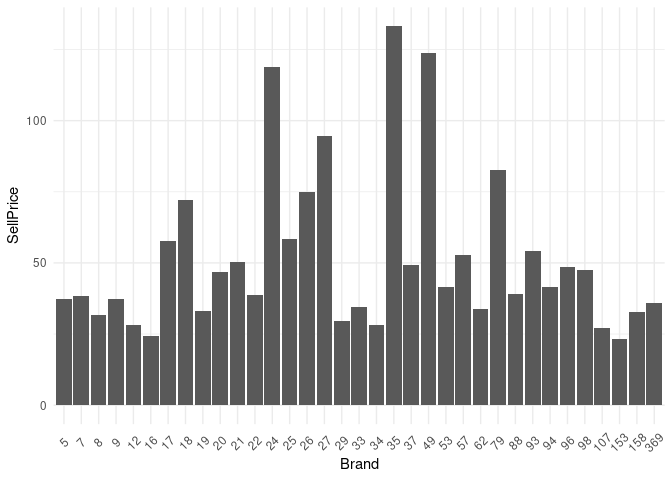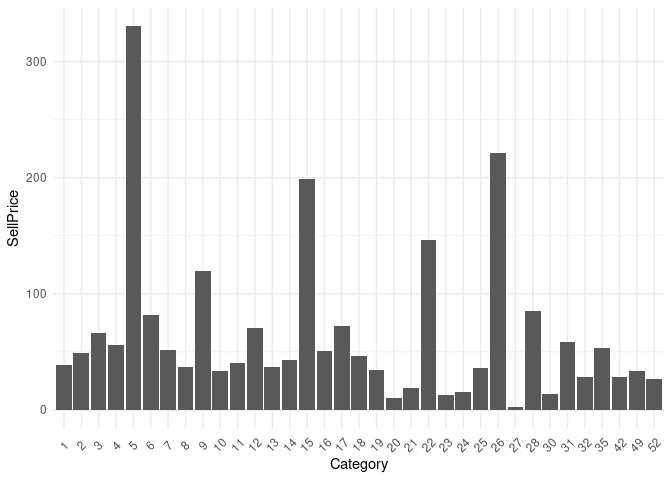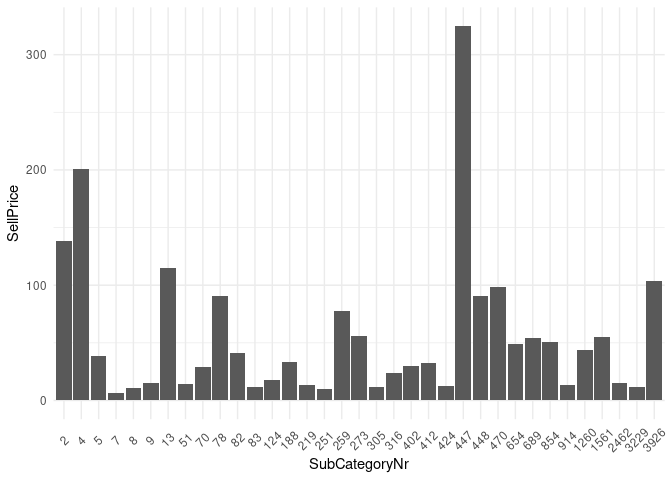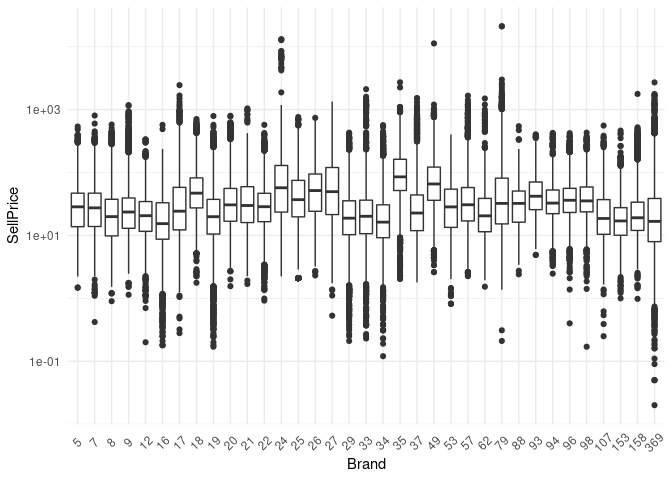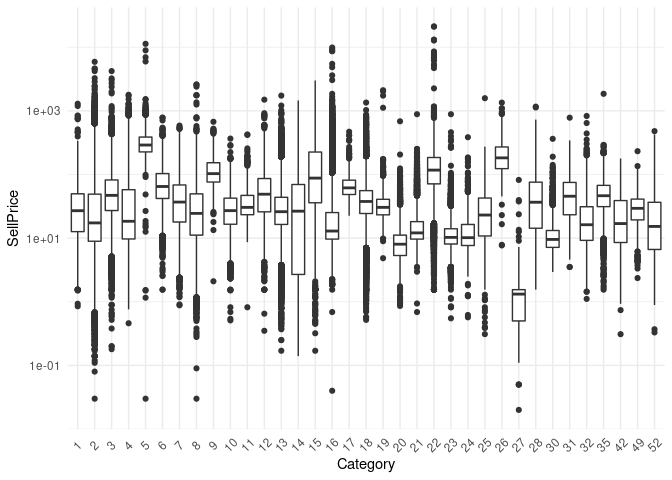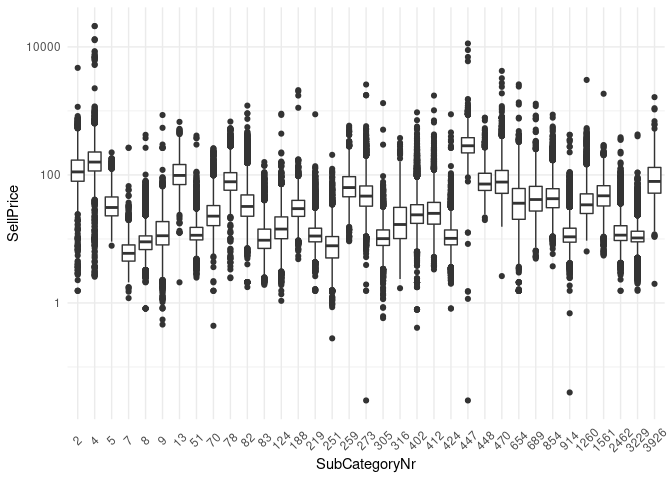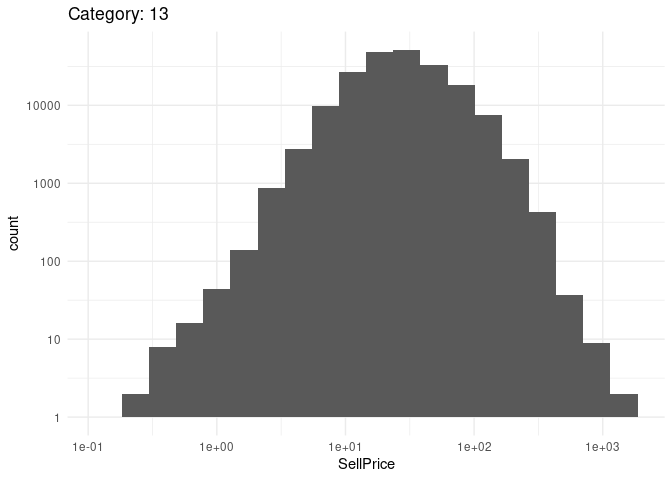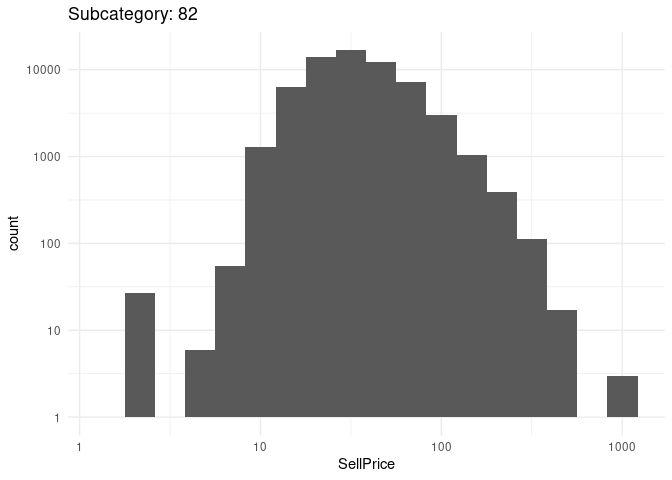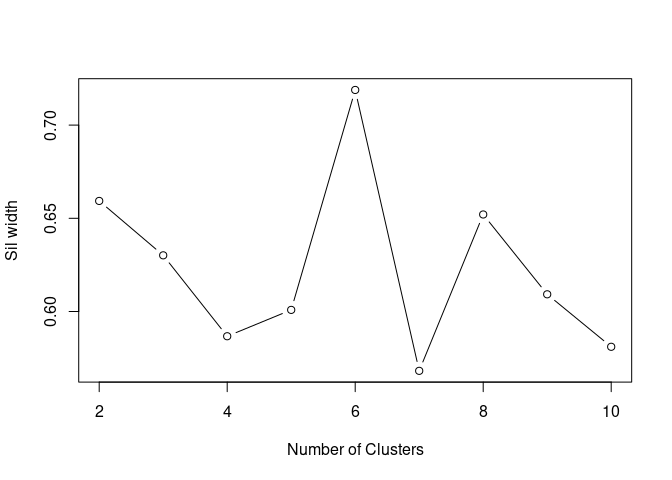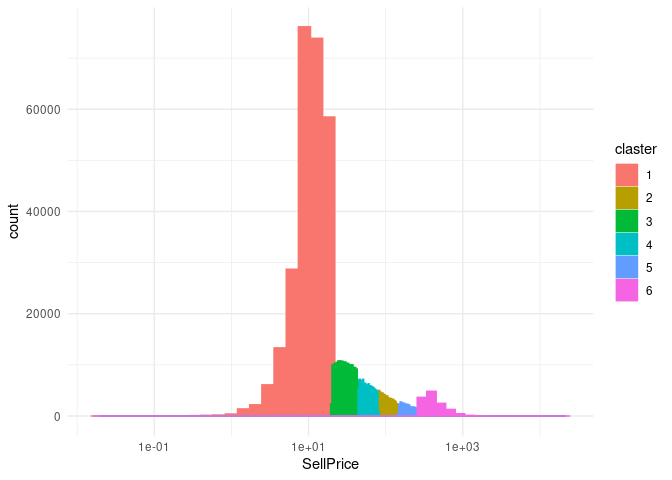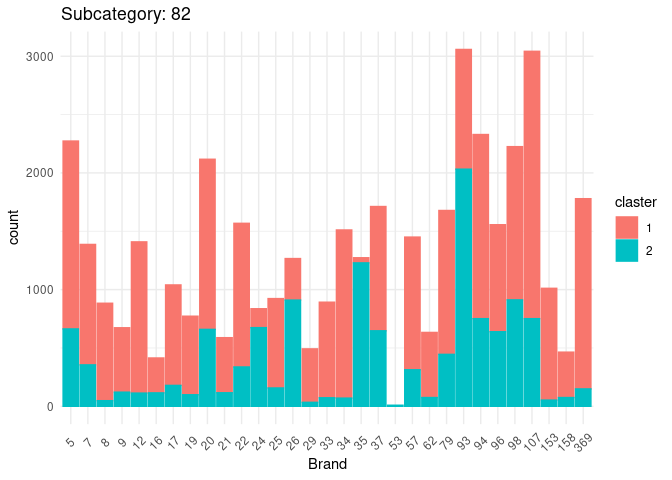| title | author |
|---|---|
exploratory analysis (in R) |
Kozhin PM |
library(tidyverse)test_price = read.csv("data.csv")
head(test_price)## id Brand SubCategoryNr Category SellPrice
## 1 452798 79 3488 36 10.92
## 2 599859 79 1485 36 112.04
## 3 183475 79 1485 36 25.09
## 4 552471 79 3282 36 1.40
## 5 589285 79 3282 36 2.28
## 6 500050 33 1496 36 0.25
- Описательная статистика
top_brand_all <- test_price %>% count(Brand, sort = TRUE) %>% .[[1, 1]]
top_category_all <- test_price %>% count(Category, sort = TRUE) %>% .[[1, 1]]
top_subcategory_all <- test_price %>% count(SubCategoryNr, sort = TRUE) %>% .[[1, 1]]
tops <- tibble(Top = "Top", Brand = top_brand_all, Category = top_category_all, SubCategoryNr = top_subcategory_all) %>% column_to_rownames("Top")Cамый частотный бренд, категория, подкатегория
print(tops)## Brand Category SubCategoryNr
## Top 369 13 82
#переопределим функции с заданными аргументами по умолчанию для 25 и 75 процентиля
quantile75 <- function(x) quantile(x, probs = 0.75)
quantile25 <- function(x) quantile(x, probs = 0.25)
fun_range <- function(x) range(x)[2]-range(x)[1]
descriptive_stat_on_top_subcategory_in_top_category_in_top_brand <-
test_price %>%
filter(Brand == top_brand_all & Category == top_category_all & SubCategoryNr == top_subcategory_all) %>%
summarise_at('SellPrice',
list(Mean_price = mean,
Median_price = median,
Min_price = min,
Max_price = max,
Q25 = quantile25,
Q75 = quantile75,
Range = fun_range)) %>%
mutate(Top = str_c('Brand:', top_brand_all,
'Category:', top_category_all,
'SubCategoryNr:', top_subcategory_all,
sep = ' '),
.before = everything())top_categories <- c('Brand', 'Category', 'SubCategoryNr')
# создаем именованный вектор. Значения (текстовые) нужны для filter, имена нужены для summarise_at .id
# цифровые значения бренда, категории, субкатегории нужны для filter
names(top_categories) <- map2_chr(top_categories, c(top_brand_all, top_category_all, top_subcategory_all), ~str_c(.x, .y, sep = ": "))
descriptive_stat_on_top <- top_categories %>%
syms() %>%
map2_df(c(top_brand_all, top_category_all, top_subcategory_all),
#анонимная функция фильтрует датафрейм по самому частому бренду, категории или субкатегории, считает статистику для каждого значения filter. map2_df собирает все в единый датафрейм
~(test_price %>%
filter(!!.x == .y) %>%
summarise_at('SellPrice',
list(Mean_price = mean,
Median_price = median,
Min_price = min,
Max_price = max,
Q25 = quantile25,
Q75 = quantile75,
Range = fun_range))),
.id = 'Top')
#соединяем два датафрейма в один
descriptive_stat_on_top <- descriptive_stat_on_top %>% bind_rows(descriptive_stat_on_top_subcategory_in_top_category_in_top_brand)Размах цен для самого частотного бренда, категории, подкатегории
descriptive_stat_on_top %>% select(Top, Range) %>% print()## Top Range
## 1 Brand: 369 2712.32
## 2 Category: 13 1735.56
## 3 SubCategoryNr: 82 1207.98
## 4 Brand: 369 Category: 13 SubCategoryNr: 82 749.39
Медиана для самого частотного бренда, категории, подкатегории. (распределение цен асимметричное, корректнее использовать медиану)
descriptive_stat_on_top %>% select(Top, Median_price) %>% print()## Top Median_price
## 1 Brand: 369 16.73
## 2 Category: 13 26.03
## 3 SubCategoryNr: 82 32.16
## 4 Brand: 369 Category: 13 SubCategoryNr: 82 18.01
- Сделаем график Распределения TOP35 иерархий(бренд, категория, подкатегория) по ценам
top_brand_35 <- test_price %>% count(Brand, sort = TRUE) %>% .[c(1:35), 1]
top_category_35 <- test_price %>% count(Category, sort = TRUE) %>% .[c(1:35), 1]
top_subcategory_35 <- test_price %>% count(SubCategoryNr, sort = TRUE) %>% .[c(1:35), 1]top_brand_bar <- test_price %>%
filter(Brand %in% top_brand_35) %>%
ggplot(aes(x = as_factor(Brand), y = SellPrice))+
stat_summary(fun = "mean", geom = "bar")+
labs(x = 'Brand')+
theme_minimal()+
theme(axis.text.x = element_text(angle = 45, hjust = 0.5, vjust = 0.5))
top_brand_bartop_category_bar <- test_price %>%
filter(Category %in% top_category_35) %>%
ggplot(aes(x = as_factor(Category), y = SellPrice))+
stat_summary(fun = "mean", geom = "bar")+
labs(x = 'Category')+
theme_minimal()+
theme(axis.text.x = element_text(angle = 45, hjust = 0.5, vjust = 0.5))
top_category_bartop_subcategory_bar <- test_price %>%
filter(SubCategoryNr %in% top_subcategory_35) %>%
ggplot(aes(x = as_factor(SubCategoryNr), y = SellPrice))+
stat_summary(fun = "mean", geom = "bar")+
labs(x = 'SubCategoryNr')+
theme_minimal()+
theme(axis.text.x = element_text(angle = 45, hjust = 0.5, vjust = 0.5))
top_subcategory_barplots_bar <- c(list(top_brand_bar), list(top_category_bar), list(top_subcategory_bar))- Построим диаграмму размаха boxplot иерархий по ценам
#boxplot w/ outliers. Для визуализации всех значений нужно ось 'y' преобразовать в log10
top_brand_box <- test_price %>%
filter(Brand %in% top_brand_35) %>%
ggplot(aes(x = as_factor(Brand), y = SellPrice))+
geom_boxplot()+
scale_y_log10()+
labs(x = 'Brand')+
theme_minimal()+
theme(axis.text.x = element_text(angle = 45, hjust = 0.5, vjust = 0.5))
top_brand_boxtop_category_box <- test_price %>%
filter(Category %in% top_category_35) %>%
ggplot(aes(x = as_factor(Category), y = SellPrice))+
geom_boxplot()+
scale_y_log10()+
labs(x = 'Category')+
theme_minimal()+
theme(axis.text.x = element_text(angle = 45, hjust = 0.5, vjust = 0.5))
top_category_boxtop_subcategory_box <- test_price %>%
filter(SubCategoryNr %in% top_subcategory_35) %>%
ggplot(aes(x = as_factor(SubCategoryNr), y = SellPrice))+
geom_boxplot()+
scale_y_log10()+
labs(x = 'SubCategoryNr')+
theme_minimal()+
theme(axis.text.x = element_text(angle = 45, hjust = 0.5, vjust = 0.5))
top_subcategory_boxplots_box <- c(list(top_brand_box), list(top_category_box), list(top_subcategory_box))- Построим распределение интервалов цен по самому частотному бренду, категории, подкатегории
- Разбъем товары на кластеры по цене.
test_price_clustering <- test_price
# Определим количество кластеров с помощью avarage silhouette width
library(cluster)
set.seed(735)
sil.width <- map_dbl(2:10,
function(k){model <- clara(x = test_price_clustering[5], k = k, samples = 50, rngR = TRUE)
return(model$silinfo$avg.width)
}
)
plot(2:10, sil.width, type = "b",
xlab = "Number of Clusters",
ylab = "Sil width")# -> Выбираем с наимбольшим "Sil width". Таким образом получаем 6 кластеров
kn = which.max(sil.width)+1 # отсчет от 2х, поэтому +1
k6 <- clara(x = test_price_clustering[5], k = kn, samples = 50, rngR = TRUE)
test_price_clustering$claster <- as.factor(k6$clustering)#визуализируем разбиение по кластерам. В первом графике для наглядности визуализации взяты данные с SellPrice < 500
test_price_clustering %>% ggplot(aes(x = SellPrice, colour = claster, fill = claster))+
geom_histogram(binwidth = function(x) (max(x)-min(x))/nclass.Sturges(x))+
scale_x_continuous(limits = c(0,500))+
labs(x = "SellPrice < 500")+
theme_minimal()test_price_clustering %>% ggplot(aes(x = SellPrice, colour = claster, fill = claster))+
geom_histogram(binwidth = function(x) (max(x)-min(x))/nclass.Sturges(x))+
scale_x_log10()+
theme_minimal()- Разобъем самую популярную субкатегорию на ценовые кластеры, и посчитаем количество товаров для популярных брендов в каждом кластере
library(cluster)
test_price_clustering_subcategory_top <- test_price_clustering %>% filter(SubCategoryNr == top_subcategory_all)
set.seed(735)
sil.width <- map_dbl(2:10,
function(k){model <- clara(x = test_price_clustering_subcategory_top[5], k = k, samples = 50, rngR = TRUE)
return(model$silinfo$avg.width)
}
)
plot(2:10, sil.width, type = "b",
xlab = "Number of Clusters",
ylab = "Sil width")# -> Выбираем с наимбольшим "Sil width". Таким образом получаем 2 кластеров
kn = which.max(sil.width)+1 # отсчет от 2х, поэтому +1
k2 <- clara(x = test_price_clustering_subcategory_top[5], k = kn, samples = 50, rngR = TRUE)
test_price_clustering_subcategory_top$claster <- as.factor(k2$clustering)
test_price_clustering_subcategory_top %>% filter(Brand %in% top_brand_35) %>%
ggplot(aes(x = as.factor(Brand), color = claster, fill = claster))+
geom_bar(stat = "count")+
labs(x = "Brand", title = str_c("Subcategory: ", top_subcategory_all))+
theme_minimal()+
theme(axis.text.x = element_text(angle = 45, hjust = 0.5, vjust = 0.5))test_price_clustering_top <- test_price_clustering %>% group_by(claster) %>% count(Brand, sort = TRUE) %>% slice_head(n = 20) %>% left_join(test_price_clustering)
head(test_price_clustering_top)## # A tibble: 6 × 7
## # Groups: claster [1]
## claster Brand n id SubCategoryNr Category SellPrice
## <fct> <int> <int> <int> <int> <int> <dbl>
## 1 1 369 22347 649194 1485 36 10.1
## 2 1 369 22347 666869 3488 36 2.09
## 3 1 369 22347 666870 3488 36 3.74
## 4 1 369 22347 667277 3488 36 3.05
## 5 1 369 22347 667287 1496 36 1.55
## 6 1 369 22347 667405 3767 36 1.55
stat_test_price_clustering_top <- test_price_clustering_top %>% group_by(Brand, claster, Category, SubCategoryNr) %>% summarise(Mean = mean(SellPrice))
stat_test_price_clustering_top %>% ggplot(aes(y = Mean, x = as.factor(Brand)))+
geom_jitter(aes(color = as.factor(claster)), alpha=0.2)+
scale_y_log10()+
labs(x = "Brand", color = "Claster")+
theme_minimal()+
theme(axis.text.x = element_text(angle = 45, hjust = 0.5, vjust = 0.5))Построим дендрограмму кластеризации
test_price_clustering_top_chr <- test_price_clustering_top %>%
mutate_at(c("Category", "SubCategoryNr", "Brand"), as.character) %>%
mutate(SellPrice = log10(SellPrice)/max(log10(SellPrice))) %>%
group_by(Brand) %>%
summarise(Mean = mean(SellPrice)) %>%
remove_rownames() %>%
column_to_rownames("Brand") %>%
arrange(desc(Mean))
res.diana <- diana(test_price_clustering_top_chr)
plot(as.dendrogram(res.diana))test_price_clustering_top_chr## Mean
## 214 0.9388566
## 177 0.9364986
## 176 0.9345208
## 215 0.9334185
## 45 0.9323937
## 87 0.9285059
## 93 0.9280570
## 31 0.9266951
## 28 0.9248560
## 88 0.9212167
## 212 0.9175342
## 25 0.9163623
## 26 0.9141069
## 98 0.9117193
## 186 0.9055439
## 18 0.9052500
## 94 0.8956228
## 35 0.8924015
## 24 0.8871545
## 20 0.8856785
## 22 0.8793608
## 57 0.8790243
## 7 0.8741192
## 27 0.8733297
## 5 0.8688404
## 79 0.8582853
## 37 0.8480928
## 49 0.8470651
## 9 0.8462763
## 175 0.8428535
## 107 0.8351166
## 8 0.8345207
## 12 0.8319649
## 19 0.8185107
## 33 0.8150536
## 17 0.8043643
## 29 0.8043142
## 34 0.7934502
## 153 0.7865610
## 369 0.7819065
## 2 0.7539992
## 16 0.7065821
## 85 0.6292932
## 271 0.6290404
## 272 0.6270406
## 47 0.6068690
## 217 0.6044709
## 42 0.6027534
## 48 0.5962213
возьмем для одного бренда в 5 кластере случайную категорию и сравним распределение цен с остальными
set.seed(934)
test_price_clustering_top %>% mutate(brand35 = case_when(Brand == 35 ~ "35",
TRUE ~ "Other")) %>%
ungroup() %>%
filter(Category == sample(Category, 1), claster == "5") %>%
ggplot(aes(x = SellPrice, fill = brand35))+
geom_density(alpha = 0.4)+
labs(title = str_c("Category: ", test_price_clustering_top$Category[1]))+
theme_minimal()